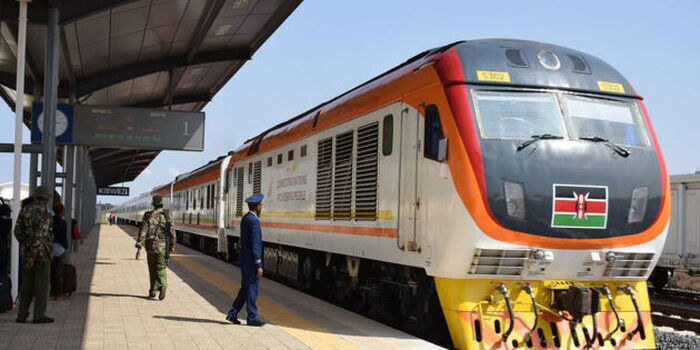The Standard Gauge Railway recorded a passenger drop of 50,780 and experienced a reduction in cargo volumes, a report from the Kenya National Bureau of Statistics (KNBS) has shown.
According to the Third Quarter Gross Domestic Product Report 2024 released on Tuesday, January 7, commuters using train services reduced from 701,132 passengers in the third quarter of 2023 to 650,352 passengers in the same period in 2024.
The report indicated that the decline represented 7.2 per cent drop in passengers ferried by the train service.
Similarly, a dip in cargo transported through SGR was recorded dealing a major blow to the services and operations of the train service.
Former President Uhuru Kenyatta (in white construction helmet) during the launch of the SGR Phase 2A construction in 2019
PSCU
“Freight transported via SGR contracted by 0.8 per cent to stand at 1,720.3 thousand metric tonnes during the period under consideration compared to 1,735.0 thousand metric tonnes in the third quarter of 2023,” KNBS stated.
Despite SGR recording reduced cargo volumes, the Port of Mombasa recorded a 14.1 per cent throughput from 8,942.9 thousand metric tonnes in the third quarter of 2023 to 10,204.4 thousand metric tonnes in the review period.
The increase in port activity reflected the overall improvements witnessed in the transport and storage services sector which grew by 5.2 per cent in the third quarter of 2024 compared to 5.1 per cent growth in the corresponding quarter of 2023.
In addition, consumption of light diesel, a key input for land transportation, increased by 2.7 per cent from 557.6 thousand metric tonnes in the third quarter of 2023 to 572.8 thousand metric tonnes in the period under review, further boosting the transport sector.
At the same time, the Kenyan economy experienced its slowest rate of growth in four years as the country faced the decelerated growth in most sectors of the economy.
According to the report, the economy experienced a growth of 4 per cent, down from 6 per cent in the corresponding period in 2023. This was lower compared to 2022 where third quarter economic growth was 4.6 per cent and 9.4 per cent growth in 2021.
That was below the Central Bank of Kenya’s forecast of 5.2 per cent and the slowest rate of growth since the first quarter of 2021.
Growth in 2024 was heavily affected by a decline in the construction, mining and quarrying sectors that contracted by 2 per cent and 11.1 per cent respectively according to the Kenya National Bureau of Statistics (KNBS).
.”The decelerated growth was largely due to a general decline in growth in most sectors of the economy. The growth was constrained by contractions in construction and mining and quarrying activities,” KNBS stated.
The decelerated growth painted a grim picture of 2024, with the new development also attributable to the July-August protests that resulted in political instability during that period.
Nationwide protests, dubbed the anti-Finance Bill protests, against proposed tax increases at the end of the second quarter resulted in disruptions and incidents of violence in major towns.
President William Ruto subsequently scrapped the tax measures, but demonstrations persisted into the third quarter, with protesters calling for better governance, an end to corruption, and better service delivery.
Even so, improvements in agriculture, forestry, fishing, financial and insurance services, real estate, wholesale and retail, accommodation, and food services shielded the economy from slowing further.
President William Ruto in a church, October 27, 2024.
William Ruto


